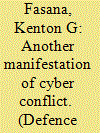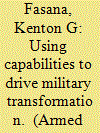| Srl | Item |
| 1 |
ID:
159189


|
|
|
|
|
| Summary/Abstract |
Cyberspace is an avenue of approach through which a military force can attain objectives of value. Through these cyber avenues of approach, military forces can engage, vet, organize, and direct human agents to accomplish specific activities. Although the objectives of these activities could differ from traditional military objectives, they still have military relevance. This particular manifestation of cyber conflict is neither a new domain of war nor something outside of warfare. Rather, it can be viewed as an emerging avenue of approach in the larger context of military operations, auguring benefits in the integration of cyber activities with operations.
|
|
|
|
|
|
|
|
|
|
|
|
|
|
|
|
| 2 |
ID:
101330


|
|
|
|
|
| Publication |
2011.
|
| Summary/Abstract |
Former cold war nations are grappling with how to transform their militaries in light of new strategic challenges. The implementation of these initiatives often requires a great deal of civil-military interaction. In developing transformational concepts, many of these countries rely on a functional view of capabilities. This article proposes an alternative capabilities model based on the interaction of effects, time, and space and asserts that this model has certain advantages vis-à-vis military transformation. To make its case, this article examines the effectiveness of both capability models in developing transformational concepts. It then uses the case study method to demonstrate the alternative model's practical utility. The results of this analysis indicate that the alternative capabilities model has certain advantages in developing transformational initiatives, integrating these initiatives with defense processes, and communicating these proposals to civilian leaders. The new model is not meant to replace but to complement the functional one.
|
|
|
|
|
|
|
|
|
|
|
|
|
|
|
|